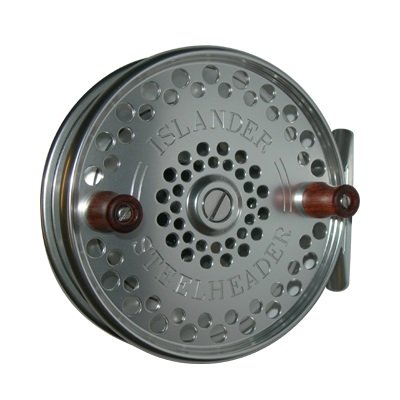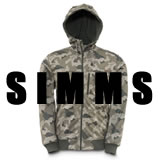by Rod Griffin, Owner and Guide at Griff's Fly Fishing Adventures
To read part one: scroll down.
THE NUTS AND BOLTS:.
I am a “figure it out for yourself” kind of guy. I have to chew on all the information I can find on a subject and then put it to work my way. Learning how to fish with centerpin equipment was no different. I wasn't sure that it was something I was going to really like at first. So, I didn't want to invest a bunch of money in gear that I may only use a few times. I had no one close by that was into a centerpin so I could give it a try. Probably a good thing, because there is a learning curve involved - especially the casting. It takes some coordination to get it done.
My friend Bruce Belles, the main man, at Clackacraft Drift Boats recommended that I start out with some equipment made by Okuma. He said - “I have all kinds of rods and reels, but I have found Okuma rods and reels to be more than adequate for the job at a very reasonable cost.” So, taking Bruce's advice, I bought a 13 ½ ' Okuma Guide Select Rod and Aventi Reel. Bruce also recommended Raven mono – so that is what I did along with Raven fixed balsa floats in different sizes. I now have several different rods, and a Ross Flow Reel, but I find myself using the Okuma set-up more than not. I caught a steelhead at Effy's Bridge on the Methow with it the first time I used it. It is still catching fish. The moral to this story: “you do not need high priced gear to get it done and have fun doing it.” Also, if something happens to it you don't panic. After all, you bought it to fish with. I just got a new TFO 13' rod and it is a great rod. They were not building them when I got started.
When it comes to terminal gear, I use Raven 8 or 10 pound Hi-Vis yellow mono mainline, swivels, split shot, and floats. It is what I started with and it works just fine. Raven has a system they have developed, and I follow that system with a few little changes here and there. Again, I was following their system when I landed my first steelhead with a pin. “If it ain't broke don't fix it.” I have used this set-up on the Methow, Grande Ronde, and Wenatchee with a few subtle changes here and there; such as float weights and shape and bug size and weight and caught fish lots of fish.
Using a pin is about having what I call an “educated finger,” just like using a bait caster is about having an “educated thumb.” It is important in making the cast, but it is also important in getting the right kind of drift. I will talk about the cast first only because you can't fish unless you get your offering into the zone. I call it the “zone” because with steelhead an inch one way or the other can make all the difference. And like fly fishing - managing line and presenting your offering properly is in my opinion at least 90% of it if not more. In other words it is important.
I watched and read everything I could on casting. I tried most of them too. I did not want to be one of those guys that can stand at the top of the drift or in a boat and just drop it in the water. A “one drummer” I call them, not that it doesn't get the job done. I do a lot of walk-in stuff on the Methow, in fact, I prefer it to being in the boat when it comes to steelhead. The reason why has nothing to do with this article; so I am just going to leave it at that. I knew to be effective in the rivers I fish; I had to be able to cast most anywhere I wanted. I can with the two casts that I use most of the time. They are also the casts that I teach to my guests. They are the “Side Cast” and the “Pulling Side Cast.” The one down side for both of these casts is: line twist. It is important to keep fresh line on your reel. One thing that works for me is: I use either Dacron fly line backing or heavy mono backing on my reels with Raven mono in hard to see green blood knotted to the backing. I then blood knot the quantity of Raven Hi-Vis line that I use to fish with to the green mono. This way I am only changing out the line that is on the water and used for casting most of the time. Works for me, and it is kind of like using tips on a Scandi or Skagit Head.
Now that you have your line in the water; you have to learn how to control your float so you maximize your effectiveness and catch fish. I do this using either the little finger of my right hand or the one next to it. I like to use a high rod tip and a controlled drift, retarding the float just a bit, to get kind of a “trotting” affect or movement with the float throughout the drift. I like the top of my float tipped upstream a bit. This presents your offering in front of everything else so the fish see it first. I also believe that the little bit of movement you get in the bug is very enticing to the fish. It is just plain “sexy.” I do this by putting just a bit of finger pressure on the freewheeling spool – either slowing it down or releasing and letting it move faster. This method is very affective for working in and around rock pockets, etc. I can tell you all about it, but it is definitely something you have to figure out for yourself. You'll know when it is right.
When it comes to what I use in my offering, I prefer nymphs or a little smaller than the norm jig style hook with custom colored 1/32 ounce heads in a variety of patterns, mostly marabou, that are more like a fly than a jig. My best friend here in the Methow has a custom jig operation, Raven Jigs, and makes some of the best steelhead patterns around. They also fish very well on a fly rod. Sometimes in a river like the Ronde or the Klickitat I will use a heavier bug. Fishing nymphs with a pin is also very affective. Sometimes I fish two bugs, but there are also times when I will fish only one especially here in the Methow. These Methow fish are very, very, trouty, and I have, over time, have gone to smaller and smaller bugs. I very seldom fish egg patterns anymore, and lean towards size. 14 and 16 standard nymph patterns like Copper Johns, Pheasant Tails, Princes, Lightning Bugs, Hare's Ears, believe it or not.
SUMMARY:.
You know, I could probably go on and on and on. It is kind of like that when you really enjoy what you do for a living. For me I love steelhead, and I am thankful every day that God allows me to be doing something that I like outside in His creation. I am first and foremost a two-handed rod angler when it comes to steelhead. However, I am finding that more and more, especially in cold conditions, I am packing two rods with me. My trusty Meiser or TFO Deer Creek and my pinning rod. I like to swing through a run first to see if I can get a player. Then more often than not, I will run the pin through it to see what I missed. There are also those runs that are next to impossible to swing that hold fish in the winter. I know how to nymph with a fly rod for steelhead, and I still do it with guests if that is what they want to do, but more and more I am giving them a third option – the Centerpin. And more and more of them are saying, “Yes.”
See ya on the river, Rod
"THE NEW KID ON THE BLOCK IN THE PACIFIC NORTHWEST - Part 1"
By Rod Griffin,
Owner and Guide at Griff's Fly Fishing Adventures
May 30, 2012
It is interesting how we evolve as anglers. I have done it all. I have drifted with conventional tackle. I
have back-trolled plugs from both a drift boat and a jet sled. There was even a time when I drifted bait
with a noodle rod. And then came fly
fishing. Fly fishing has been my choice
of angling for close to 30 years now. Yeah that’s right, even before "A
River Runs Through It." On the
rivers that I fish today, I use both single-handed and double-handed fly
rods. I really like using the
double-handers including the relatively new switch rods that are available today. I use an 11 ft. 5 weight for trout here on
the Methow and for bass on the Okanogan, Lower Yakima, and Grande Ronde.
I am a steelhead bum at heart, and there is no better way to pursue them then
being armed with a double-handed rod. I
prefer to swing flies for steelhead. And
for these east-side summer runs, the best time for that is in the warmer
months, with late August through the first part of November being prime
time. The conditions at this time of
year, especially the water temperatures, are ideal for swinging with a dry
line. I like 11 ft. to 13 1/2 ft.
two-handers with compact Scandi heads for this job. As the water temperatures
fall below 45 degrees, the use of Skagit heads with sink tips becomes more and
more critical to catching fish on the swing. Like it or not, I have had to accept that when it comes to catching steelhead
with flies, the single most effective way to do that is dead drift nymphing
with a dry line and bobber; just as you would for trout. “UNTIL NOW!”
About five years ago, I got interested in a relatively new
technique of steelhead fishing that was starting to show up in the Pacific
Northwest. Two friends, Bruce Belles and
Eric Nuefeld, both highly regarded in the fly fishing industry started telling
me about a technique called “the centerpin”.
I figured if Bruce and Eric are into it, it can't be all bad. So being the open minded inquisitive guy that
I am, I started doing some on-line research about it and was surprised at how
much information, especially “YouTube” stuff that I found.
I am an east-side steelhead guide as I mentioned
earlier. This means, that I am dealing
with summer run fish hanging out in very cold water from mid-November into
February. These fish are not very active
residing in deeper, slower, pools and not really excited about moving to a
swung fly. As a result, I had to resort
to using nymphing techniques to get clients into fish consistently. After all, I do get paid to help people catch
fish. The Centerpin has given me another
very effective weapon in my arsenal that is, in my opinion, probably the single
most efficient and effective way to catch the great silver and Rose colored
ghost of our Northwest Rivers. Oh by the
way, it is fun too! It’s a good balance between fly fishing and conventional gear
fishing.
A TRADITIONAL
METHOD OF FISHING:.
Centerpin angling is not a new concept. It is really a traditional style of fishing,
which like double-handers was born in the UK in the 1800’s. It is very popular on British Columbia Steelhead
Rivers and has been for many years. In
the U.S., it first started gaining a following in the mid-west and eastern
states with the development of the steelhead fishery on the rivers of the Great
Lakes. It is also growing in popularity
in Alaska. Although relatively new in
the Pacific Northwest, it is becoming more popular for steelhead. More and more fly rod anglers are using this
technique as an alternative way to catch fish when swinging just doesn't get it
done. Most are two-handed rod junkies
who refuse to use a bobber with a double-hander. Some Washington and Oregon fly shop owners
have seen an opportunity to get in on the ground floor and are now stocking and
selling center pin rods, reels, and gear.
Ross Reels is making a great center pin reel called the Flow, and some
rod companies are designing, building, and marketing centerpin rods. Both Loomis and TFO currently have center pin
rods on the market. Raven, a Canadian
Company, makes rods, reels, and gear that are very popular in this country and
throughout the world. Okuma long known
for quality, affordable, conventional equipment is making very good rods and
reels that are very affordable and catch fish too.
 |
| Releasing a centerpin caught steelhead |
The theory behind this technique is a long, drag free drift. For me, it means that I can use this technique to help guests’ present subsurface flies or patterns using small jig style hooks in a way that is very enticing to a steelhead, especially during cold water periods. The time of year when summer run, East side fish are not as easily moved to a fly; you have to bump them on the nose to get them to eat your offering.
THE EQUIPMENT:.
Centerpin reels are extremely smooth, machined, single-action reels much like
fly reels of old with no drag system except for a clicker. The clicker is used to keep the reel from
rotating freely when not fishing. It is
not intended to be used for a drag. In
other words, if you put the rod tip in the air with your set-up hanging down without
the clicker engaged everything will drop to the ground. They have rimmed spools so the necessary drag
is applied by hand when fighting a fish.
This, by the way, is the same way I fight fish on my fly reel. I have never relied on the drag and prefer
the old Hardy’s and click drag systems.
The rods are long, lite, and responsive.
Probably the most popular length of rod in the NW right now is 13 ft. or
13 ft. 6 in. rod. I use both rods for
what I am doing here on the Methow or any of the other east side rivers I fish.
I have been using a centerpin for three years now. Like many other NW anglers, I taught myself.
I read a lot of books, looked at a lot of websites, and asked a lot of
questions; then put it all to work on the river. Trust me it is definitely a
deadly technique for catching steelhead.
There is a learning curve, but that can be shortened by fishing with
someone who has already made most of the mistakes.
Centerpinning is an awesome traditional approach to catching
fish. The center pin can not only save the day, but is also a very pleasant,
challenging way to fish. Careful though,
like fishing with a double-hander it can become addictive. It is a great way to fish the Methow,
Wenatchee, or Grande Rhonde throughout the winter.








.jpg)





No comments:
Post a Comment